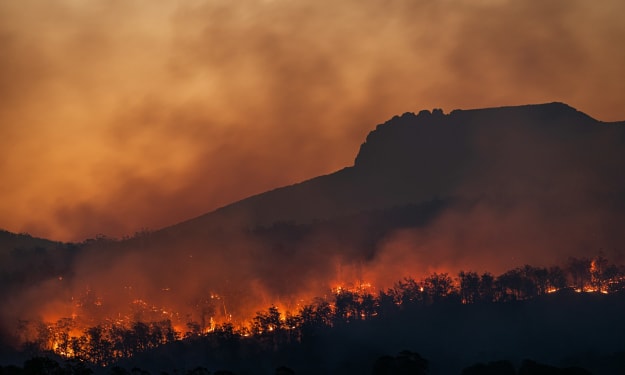Major Wildfire Activity in California, Australia, and the Amazon. A Story of Environmental Catastrophe
Wildfires have long been a natural occurrence in various ecosystems around the world. However, in recent years, major wildfires have reached unprecedented levels of intensity and devastation.

Introduction
Wildfires have long been a natural occurrence in various ecosystems around the world. However, in recent years, major wildfires have reached unprecedented levels of intensity and devastation. This article explores the alarming wildfire activity in three significant regions: California, Australia, and the Amazon. These regions have been severely affected by wildfires, leading to immense ecological damage, loss of lives, displacement of communities, and economic repercussions. Understanding the causes, impacts, and responses to these wildfires is crucial for developing effective strategies to mitigate future disasters and safeguard our planet.
California's Wildfire Crisis
1.1. Causes and Contributing Factors
California has experienced a recurring wildfire crisis, fueled by a combination of natural and human-induced factors. Climate change has intensified the state's drought conditions, creating dry vegetation that serves as ideal fuel for wildfires. Additionally, urban sprawl has expanded into wildfire-prone areas, increasing the likelihood of ignition sources such as power lines or human activities.
1.2. Impacts and Consequences
The consequences of California's wildfires have been devastating. Homes have been destroyed, and lives have been lost, as communities grapple with the emotional and physical toll of these disasters. The economic impact is staggering, with billions of dollars spent on firefighting efforts and post-fire recovery. Moreover, the long-term ecological effects are significant, as entire ecosystems are disrupted, leading to habitat loss and threatening the survival of various plant and animal species.
1.3. Response and Mitigation Efforts
California has implemented various strategies to combat wildfires, including improved fire management practices, early warning systems, and public education campaigns. The state has also invested in technological advancements like remote sensing and predictive models to enhance fire detection and prevention. However, the scale and frequency of wildfires continue to challenge these efforts, highlighting the need for continuous adaptation and innovative solutions.
Australia's Firestorms
2.1. The Influence of Climate and Weather Patterns
Australia's unique climate and weather patterns, such as hot and dry summers, have created the perfect conditions for firestorms to thrive. Climate change has exacerbated these conditions, leading to longer fire seasons and extreme weather events, including heatwaves and droughts. Additionally, the presence of highly flammable vegetation, such as eucalyptus forests, further escalates the severity of wildfires.
2.2. Devastation and Ecological Impact
Australia's recent wildfires have been catastrophic, affecting both rural and urban areas. The 2019-2020 bushfire season, in particular, resulted in widespread destruction, loss of life, and displacement of communities. The ecological impact has been profound, with vast areas of unique and diverse ecosystems reduced to ashes. Threats to endangered species, such as the koala and kangaroo, have raised concerns about their long-term survival.
2.3. Building Resilience and Adaptive Measures
Australia has increased its focus on improving fire resilience and adaptive measures. This includes enhancing firefighting capabilities, implementing controlled burns, and investing in early warning systems. The country has also emphasized community engagement and collaboration, fostering partnerships between government agencies, researchers, and local communities to promote fire prevention and preparedness.
The Amazon Rainforest: The Lungs of the Earth in Flames
3.1. Deforestation and Human Activities
The Amazon rainforest, often referred to as the "lungs of the Earth," has experienced a surge in wildfire activity, primarily due to deforestation and human activities such as illegal logging, land encroachment, and slash-and-burn agriculture. These activities reduce the forest's capacity to retain moisture and increase the risk of accidental fires spreading uncontrollably.
3.2. Environmental and Global Implications
The Amazon wildfires have far-reaching consequences. The rainforest acts as a vital carbon sink, absorbing greenhouse gases and mitigating climate change. However, when the forest burns, vast amounts of carbon dioxide are released into the atmosphere, exacerbating global warming. The loss of biodiversity and destruction of indigenous lands further perpetuate the ecological crisis and disrupt the delicate balance of the region.
3.3. Preservation and International Cooperation
Preserving the Amazon rainforest requires international cooperation and concerted efforts. Countries sharing the Amazon basin, including Brazil, have faced scrutiny and pressure to combat deforestation. Conservation initiatives, investment in sustainable livelihoods for local communities, and stricter enforcement of environmental regulations are crucial to safeguarding this irreplaceable ecosystem.
Conclusion
The major wildfire activity witnessed in California, Australia, and the Amazon highlights the urgent need for a comprehensive approach to wildfire prevention and mitigation. Climate change, human activities, and ecosystem disruption have fueled the intensity and frequency of these wildfires, causing irreparable damage to the environment, endangering lives, and threatening global climate stability. Adequate investment in fire management systems, collaboration among governments and communities, and addressing the root causes of wildfires are essential to protect these vulnerable regions and preserve our planet's biodiversity. Only by recognizing the gravity of the situation and taking proactive steps can we hope to prevent future catastrophic events and secure a sustainable future.
About the Creator
Faisal Niaz
From a very young age, Faisal Niaz developed a deep connection with the mountains. He would often climb the gentle slopes near his home, feeling a sense of freedom and exhilaration with every step he took.






Comments
There are no comments for this story
Be the first to respond and start the conversation.